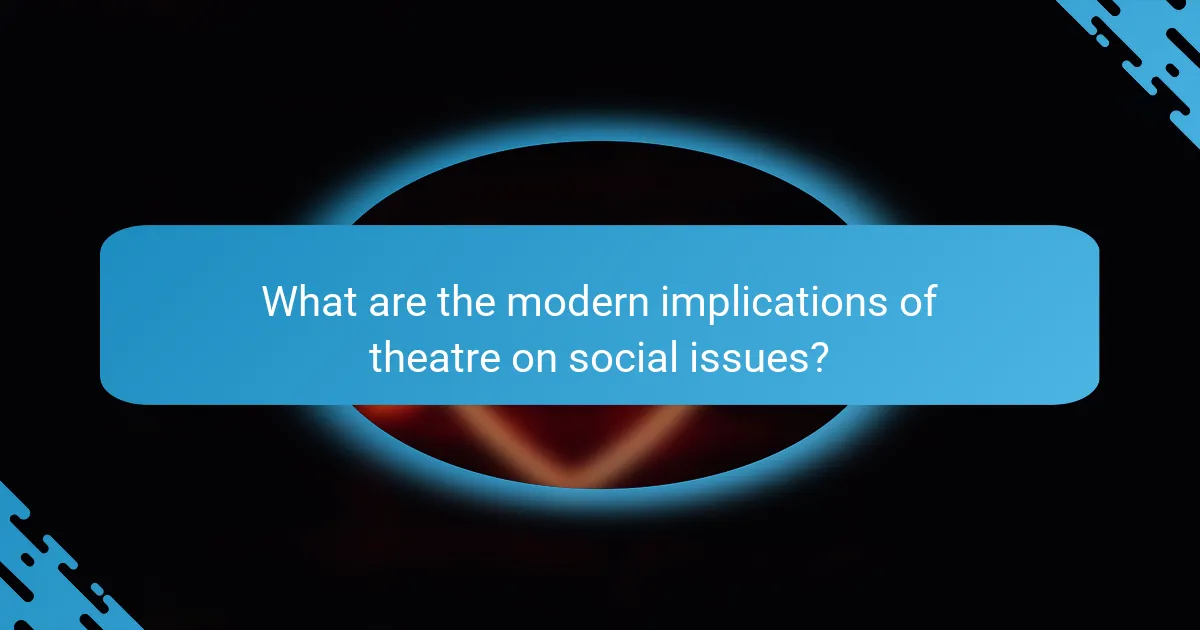The article examines the impact of theatre on social change throughout history, highlighting its role as a platform for addressing societal issues and challenging norms. Key historical periods, including Ancient Greece, the Renaissance, and the 20th century, are explored to demonstrate how theatre has influenced social perspectives. Notable works such as those by Sophocles, Shakespeare, and plays like “A Raisin in the Sun” illustrate the medium’s capacity to provoke thought and inspire activism. The article also discusses contemporary theatre’s relevance in addressing modern social issues, emphasizing its ability to foster dialogue and increase civic engagement. Through these insights, the article underscores theatre’s dual role as a mirror reflecting societal challenges and a catalyst for change.

What is the Impact of Theatre on Social Change Throughout History?
Theatre has significantly influenced social change throughout history. It serves as a platform for expressing societal issues and challenging norms. For instance, the ancient Greek plays often addressed political and moral dilemmas. They encouraged public discourse and reflection on civic responsibilities. In the 20th century, theatre became a medium for social movements. Works like “A Raisin in the Sun” highlighted racial inequalities. The Theatre of the Oppressed, founded by Augusto Boal, aimed to empower marginalized communities. Such productions have sparked conversations and mobilized audiences for change. Historical evidence shows that theatre can provoke thought and inspire action.
How has theatre influenced societal norms and values?
Theatre has significantly influenced societal norms and values by challenging prevailing ideas and encouraging dialogue. It serves as a reflection of society, often addressing issues like race, gender, and class. For example, plays like “A Raisin in the Sun” have highlighted racial discrimination and the struggles of African American families. This has fostered greater awareness and empathy among audiences. Moreover, theatre has been a platform for social movements, such as the feminist theatre of the 1970s, which advocated for women’s rights and equality. The impact of such performances can lead to shifts in public perception and policy. Historical evidence shows that theatre has played a role in movements like civil rights and [censured] rights, promoting advocacy and activism. By presenting diverse narratives, theatre shapes cultural conversations and influences societal change. This dynamic interplay between theatre and society illustrates its power as a catalyst for transformation.
What historical examples illustrate theatre’s role in social movements?
Theatre has played a significant role in social movements throughout history. One prominent example is the use of theatre during the Civil Rights Movement in the United States. Productions like “A Raisin in the Sun” highlighted racial inequalities and inspired activism. Another example is the Theatre of the Oppressed, developed by Augusto Boal in Brazil. This form of participatory theatre aimed to empower marginalized communities and promote social change. Additionally, the anti-apartheid movement in South Africa utilized theatre to raise awareness and mobilize support against the regime. Performances by groups like the Market Theatre challenged racial segregation and fostered dialogue. These historical instances demonstrate how theatre has effectively communicated social issues and galvanized public action.
How do different cultures utilize theatre for social commentary?
Different cultures utilize theatre for social commentary by reflecting societal issues and provoking thought. In Ancient Greece, playwrights like Sophocles addressed moral dilemmas and political themes. In India, traditional forms like Kathakali convey social messages through elaborate storytelling. African theatre often incorporates community rituals to highlight social injustices. In the United States, works by playwrights such as Lorraine Hansberry tackle race relations and equality. Each cultural context shapes the themes and methods used in theatrical presentations. This use of theatre fosters dialogue and encourages audiences to engage with pressing social concerns.
Why is theatre considered a powerful tool for social change?
Theatre is considered a powerful tool for social change because it engages audiences emotionally and intellectually. It creates a platform for dialogue about social issues. Through storytelling, theatre can challenge societal norms and provoke critical thinking. Historical examples include plays like “A Raisin in the Sun,” which addressed racial discrimination. Studies show that theatre can foster empathy and understanding among diverse groups. Research by the National Endowment for the Arts indicates that participatory theatre can lead to community empowerment. Additionally, theatre has been used in social movements to mobilize support and raise awareness. These factors collectively illustrate theatre’s impact on promoting social change.
What psychological effects does theatre have on audiences?
Theatre has significant psychological effects on audiences. It can evoke strong emotions such as joy, sadness, and empathy. Audiences often experience catharsis, a release of pent-up emotions, through the characters’ journeys. This emotional engagement can lead to increased understanding of diverse perspectives. Research indicates that watching theatre can enhance emotional intelligence and social awareness. A study by Cohen and Moyer (2016) found that participants reported higher empathy levels after attending performances. Theatre also fosters community and connection among audience members, enhancing social bonds. Overall, theatre serves as a powerful medium for emotional and psychological exploration.
How does theatre promote empathy and understanding among diverse groups?
Theatre promotes empathy and understanding among diverse groups by presenting varied human experiences. It allows audiences to engage with characters from different backgrounds. This engagement fosters emotional connections and perspectives. Research shows that witnessing diverse narratives enhances empathy levels. A study by Cohen and Waugh (2008) found that viewing dramatic performances increases social empathy in audiences. Theatre also encourages dialogue about social issues. This dialogue can lead to increased awareness and understanding of different cultures and experiences. By reflecting societal issues, theatre invites audiences to confront their biases. This process cultivates a more inclusive community.

What are the key historical periods where theatre impacted social change?
The key historical periods where theatre impacted social change include Ancient Greece, the Renaissance, and the 20th century. In Ancient Greece, theatre served as a platform for discussing societal issues and moral dilemmas. Playwrights like Sophocles and Euripides addressed themes of justice and governance. During the Renaissance, theatre became a medium for exploring humanism and individualism. Works by Shakespeare challenged social norms and questioned authority. The 20th century saw theatre as a tool for political activism. Plays like “A Raisin in the Sun” highlighted racial inequality in America. These periods illustrate how theatre has historically influenced social perspectives and prompted change.
How did ancient theatre contribute to social dynamics?
Ancient theatre significantly contributed to social dynamics by serving as a platform for public discourse. It facilitated the exploration of societal issues, allowing audiences to engage with themes like justice, morality, and governance. The performances often reflected contemporary social norms and challenged prevailing ideologies. For instance, Greek tragedies addressed the consequences of hubris and the role of fate, prompting audiences to reflect on their own lives. Theatre also fostered community cohesion by bringing diverse groups together for shared experiences. Festivals like the City Dionysia in Athens highlighted civic pride and collective identity through dramatic competition. Additionally, the portrayal of characters from various social strata encouraged empathy and understanding among different societal groups. Historical records indicate that these performances played a role in shaping public opinion and influencing political change. Overall, ancient theatre acted as a mirror to society, prompting dialogue and reflection on social dynamics.
What were the themes of ancient plays that addressed social issues?
Ancient plays often addressed themes such as justice, morality, and the human condition. These themes reflected societal concerns and prompted discussions on ethical dilemmas. For example, Greek tragedies frequently explored the consequences of hubris and the quest for truth.
Plays like Sophocles’ “Antigone” highlighted conflicts between individual rights and state laws. This theme resonated with audiences facing political oppression. Similarly, Aeschylus’ “Oresteia” examined family loyalty and the cycle of vengeance. It raised questions about justice and societal order.
Roman playwrights like Plautus and Terence also tackled social issues. Their comedies often critiqued class distinctions and the role of women in society. Overall, ancient plays served as a mirror to their societies, fostering dialogue on pressing social matters.
How did the audience’s reception of these plays shape societal change?
The audience’s reception of these plays significantly influenced societal change. Positive reception often led to increased awareness of social issues. For example, plays addressing poverty or discrimination prompted public discourse. This discourse encouraged community action and policy reform. Historical evidence shows that productions like “A Raisin in the Sun” sparked discussions on race relations in America. Similarly, “The Vagina Monologues” raised awareness about women’s rights and violence against women. These reactions from audiences often resulted in movements for social justice. Thus, theatre served as a catalyst for change by reflecting and shaping public sentiment.
What role did theatre play during the Renaissance in social reform?
Theatre during the Renaissance played a significant role in social reform. It served as a medium for critiquing societal norms and injustices. Playwrights like Shakespeare and Marlowe highlighted issues such as class disparity and moral corruption. These works prompted audiences to reflect on their social realities. The rise of humanism influenced theatre, promoting individual thought and civic responsibility. Furthermore, public performances reached diverse audiences, fostering discussions on reform. Notably, the emergence of commedia dell’arte introduced social commentary through satire. This blend of entertainment and critique contributed to gradual societal changes. Thus, theatre was instrumental in shaping public consciousness during the Renaissance.
Which playwrights were influential in advocating for social change?
Henrik Ibsen, Bertolt Brecht, and August Wilson were influential playwrights advocating for social change. Ibsen’s works, like “A Doll’s House,” challenged societal norms regarding gender roles. Brecht introduced the concept of Epic Theatre, encouraging audiences to think critically about social issues. Wilson’s plays, particularly “Fences,” highlighted the African American experience and systemic racism. Each playwright used their platform to provoke thought and inspire action, making significant contributions to social discourse through theatre.
How did Renaissance theatre reflect the shifting social landscape?
Renaissance theatre reflected the shifting social landscape by addressing contemporary issues and societal changes. It showcased themes of individualism and humanism, aligning with the period’s emphasis on personal identity. The rise of secular plays indicated a move away from solely religious themes. This shift mirrored the increasing power of the middle class and the decline of feudalism. Notable playwrights like Shakespeare explored complex characters and social dynamics. Their works highlighted class struggles and moral dilemmas, resonating with audiences of the time. The emergence of public theatres made performances accessible to diverse social groups. This democratization of theatre contributed to the evolution of social consciousness.

What are the modern implications of theatre on social issues?
Theatre influences modern social issues by providing a platform for dialogue and reflection. It raises awareness about critical topics such as race, gender, and inequality. Contemporary plays often tackle systemic injustices, prompting audiences to engage with these issues. The immersive nature of theatre allows for emotional connections, fostering empathy among viewers. Productions like “The Vagina Monologues” and “Hamilton” address societal challenges and inspire activism. Statistics show that community-based theatre can increase civic engagement by 25%. Thus, theatre serves as both a mirror and a catalyst for social change.
How does contemporary theatre address current social injustices?
Contemporary theatre addresses current social injustices by highlighting marginalized voices and issues. It often uses storytelling to evoke empathy and provoke thought. Productions focus on themes such as racism, gender inequality, and economic disparity. For example, plays like “Sweat” by Lynn Nottage explore the impact of economic decline on working-class communities. These works encourage audiences to reflect on their own beliefs and societal structures. Additionally, many contemporary theatre companies engage in community outreach and activism. This involvement amplifies the messages portrayed on stage. Research indicates that theatre can inspire social action and change perceptions. Studies show that audience members often feel more empowered to address injustices after attending relevant performances.
What types of performances are most effective in raising awareness?
The most effective types of performances for raising awareness include street theater, documentary theater, and participatory performances. Street theater engages the public in open spaces, making social issues accessible. This form often addresses local concerns and invites direct interaction. Documentary theater uses real-life events and testimonies, creating a powerful narrative that resonates with audiences. It has been employed to highlight historical injustices and contemporary issues. Participatory performances invite audience involvement, fostering a sense of community and shared experience. Research shows that these interactive formats can lead to increased empathy and understanding among participants. The effectiveness of these performances is supported by various case studies demonstrating their impact on social movements and public discourse.
How do community-based theatre projects foster social change?
Community-based theatre projects foster social change by engaging local populations in storytelling and performance. These projects create a platform for marginalized voices. They encourage dialogue about social issues within communities. Participants often explore themes like identity, justice, and inequality. This process can raise awareness and inspire action. For example, studies show that theatre can lead to increased civic engagement. The Theatre for Social Change movement highlights successful case studies from around the world. These initiatives demonstrate measurable impacts on community cohesion and activism. Overall, community-based theatre serves as a catalyst for social transformation.
What are some best practices for using theatre as a tool for social activism?
Theatre can effectively serve as a tool for social activism by engaging audiences and provoking thought. First, it is essential to choose relevant and timely social issues to address. This ensures that the content resonates with the audience’s experiences and concerns. Next, incorporating diverse perspectives enriches the narrative. This can involve collaborating with marginalized communities to share their stories authentically.
Utilizing interactive formats can enhance audience engagement. Techniques such as forum theatre allow viewers to participate in the performance, fostering dialogue and reflection. Additionally, creating partnerships with local organizations can amplify the message. Collaborating with activists and community leaders can help reach broader audiences and strengthen the impact.
Finally, measuring the effectiveness of the theatre piece is crucial. Gathering feedback through surveys or discussions can provide insights into the audience’s perceptions and the play’s influence. These practices have been observed in successful activist theatre projects, demonstrating the potential of theatre to drive social change.
How can theatre practitioners engage with local communities effectively?
Theatre practitioners can engage with local communities effectively by creating inclusive and accessible performances. They should prioritize community input in the creative process. This can be achieved through workshops and discussions that invite local voices. Collaborating with local organizations enhances outreach and builds trust. Practitioners can also tailor performances to reflect the community’s cultural identity. Utilizing local spaces for performances increases accessibility. Research shows that such engagement fosters a sense of ownership and pride among community members. Additionally, studies indicate that participatory theatre can lead to meaningful social change by addressing local issues.
What strategies enhance the impact of theatre on social issues?
Theatre can enhance its impact on social issues through community engagement, educational outreach, and collaboration with activists. Community engagement fosters dialogue between performers and audiences. This connection allows for a deeper understanding of social issues. Educational outreach programs can raise awareness among students and marginalized groups. These programs often include workshops and discussions that encourage critical thinking. Collaboration with activists brings real-world issues to the stage. This partnership can amplify messages and mobilize audiences for social change. Research shows that productions addressing social issues often lead to increased advocacy and community involvement. For instance, the “Theatre of the Oppressed” technique has been used globally to empower marginalized voices.
The main entity of this article is theatre and its historical impact on social change. The article explores how theatre has served as a platform for addressing societal issues, challenging norms, and inspiring activism across various historical periods, including Ancient Greece, the Renaissance, and the 20th century. It highlights key examples of plays and movements that have influenced public perception and policy, as well as the psychological effects theatre has on audiences, promoting empathy and understanding. Additionally, the article discusses modern implications of theatre in addressing current social injustices and outlines best practices for using theatre as a tool for social activism.



